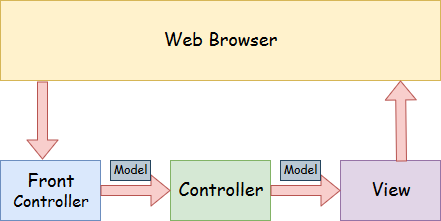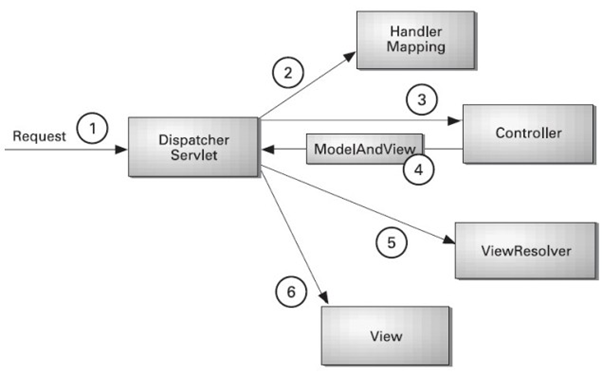tags: Spring Framework
A Spring MVC is a Java framework which is used to build web applications. It follows the Model-View-Controller design pattern.
It implements all the basic features of a core spring framework like Inversion of Control, Dependency Injection.
DispatcherServlet is the class that receives the incoming request and maps it to the right resource such as controllers, models, and views.

-
Model - A model contains the data of the application. A data can be a single object or a collection of objects.
-
Controller - A controller contains the business logic of an application. Here, the
@Controllerannotation is used to mark the class as the controller. -
View - A view represents the provided information in a particular format. Generally, JSP+JSTL is used to create a view page. Although spring also supports other view technologies such as Apache Velocity, Thymeleaf and FreeMarker.
-
Front Controller - In Spring Web MVC, the DispatcherServlet class works as the front controller. It is responsible to manage the flow of the Spring MVC application.
Understanding the flow of Spring Web MVC

- As displayed in the figure, all the incoming request is intercepted by the DispatcherServlet that works as the front controller.
- The DispatcherServlet gets an entry of handler mapping from the XML file and forwards the request to the controller.
- The controller returns an object of ModelAndView.
- The DispatcherServlet checks the entry of view resolver in the XML file and invokes the specified view component.
Advantages of Spring MVC Framework:-
- Separate roles - The Spring MVC separates each role, where the model object, controller, command object, view resolver, DispatcherServlet, validator, etc. can be fulfilled by a specialized object.
- Light-weight - It uses light-weight servlet container to develop and deploy your application.
- Powerful Configuration - It provides a robust configuration for both framework and application classes that includes easy referencing across contexts, such as from web controllers to business objects and validators.
- Rapid development - The Spring MVC facilitates fast and parallel development.
- Reusable business code - Instead of creating new objects, it allows us to use the existing business objects.
- Easy to test - In Spring, generally we create JavaBeans classes that enable you to inject test data using the setter methods.
- Flexible Mapping - It provides the specific annotations that easily redirect the page.
Spring MVC Model Interface
In Spring MVC, the model works as a container that contains the objects/data of the application.
It is required to place the Model interface in the controller part of the application. The object of HttpServletRequest reads the information provided by the user and pass it to the Model interface. Now, a view page easily accesses the data from the model part.
@Controller
public class HelloController {
@RequestMapping("/hello")
public String display(HttpServletRequest req,Model m)
{
//read the provided form data
String name=req.getParameter("name");
String pass=req.getParameter("pass");
if(pass.equals("admin"))
{
String msg="Hello "+ name;
//add a message to the model
m.addAttribute("message", msg);
return "viewpage";
}
else
{
String msg="Sorry "+ name+". You entered an incorrect password";
m.addAttribute("message", msg);
return "errorpage";
}
}
} - The HttpServletRequest is used to read the HTML form data provided by the user.
- The Model contains the request data and provides it to view page.
RequestParam
@RequestParam annotation is used to read the form data and bind it automatically to the parameter present in the provided method. So, it ignores the requirement of HttpServletRequest object to read the provided data.
@RequestMapping("/hello")
//read the provided form data
public String display(@RequestParam("name") String name,
@RequestParam("pass") String pass,Model m)
{}